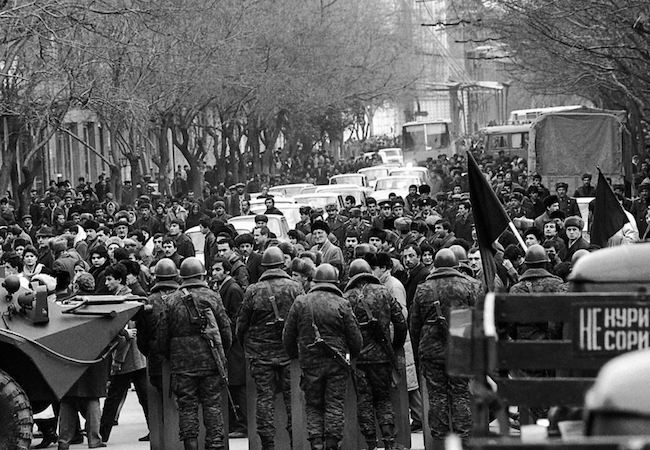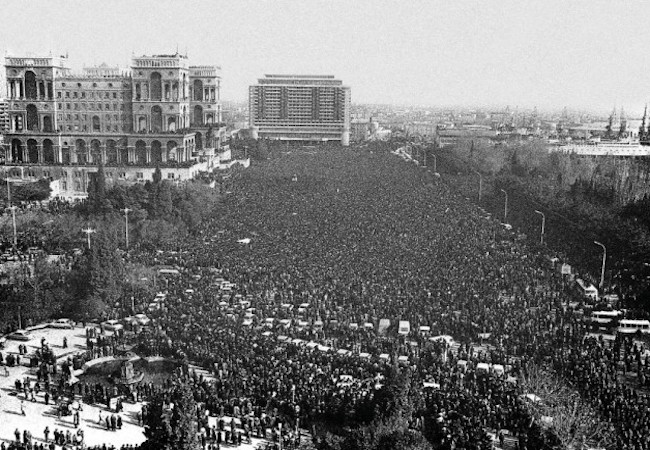Black January – Path to Independence

By Yusif Babanly
The events that took place on night of January 19-20, often referred to as Black January, is a bitter reminder that freedom is not earned that easy. That icy-cold night, when residents of Baku awoke to horrifying sounds of Soviet tanks rolling into the capital of Azerbaijan and never-ending gunfire, the entire nation woke up to its senses to break free.
The Black January massacre, often regarded as the gateway event to independence of Azerbaijan, traces its roots to the Nagorno-Karabakh conflict. If we look back at how Azerbaijan was brutally integrated into the Soviet empire, we’ll find that history – often forgotten by Azerbaijanis – does repeat itself. After the dissolution of the Transcaucasian Sejm and subsequent birth of the first Azerbaijani Democratic Republic (ADR) on May 28, 1918, the country became entangled in territorial disputes with Armenian Dashnaks and increasingly fell to the external pressure from Russian Bolsheviks, who eventually made their way into Azerbaijan.
The bitter truth about the 11th Red Army marching through the northern regions of ADR and perpetuating atrocities in its capital Baku upon the occupation of Absheron peninsula in April 1920 was soon forgotten. Or was it? Moscow’s harsh policies vis-a-vis Azerbaijanis soon begot a wave of criticism. During the next two decades, outspoken Azerbaijani critics of the Soviet system were systematically silenced, and most were completely removed from Azerbaijan during the Great Purge of 1937. Once the immediate threat to Soviet rule was tamed, mistreatment of Azerbaijani Turks was re-executed on a more massive scale. Although the mountainous part of Karabakh had already been carved out to form the so-called Nagorno-Karabakh Autonomous Oblast (NKAO) within Azerbaijan SSR in 1921, and Zangezur Uyezd was previously awarded to the Armenian SSR in 1920 at the behest of Armenian nationalists, the territorial claims to Azerbaijani lands did not stop. Shortly after World War II, Stalin signed two executive decrees of Soviet Union’s Council of Ministers No. 4083 and No. 754 on December 23, 1947 and March 10, 1948, respectively, initiating forced relocation of up to one hundred thousand Azerbaijanis from Armenia to southeastern Azerbaijan, with the objective of creating living space for Armenians who were subsequently imported there from Lebanon, Iran, and Syria. In the late 1960s, several villages of Nakhchivan and Gazakh district of Azerbaijan SSR were transferred to the Armenian SSR, gradually expanding the territory of Moscow’s most reliable ally. Silent enough, the Azerbaijani leadership succumbed to Moscow’s unjust territorial policies. In the following years, although Armenians did instigate protests in Armenia demanding the transfer of Nagorno-Karabakh itself to the Armenian SSR, their efforts fell through.
A more organized agenda was put forth after a row of Armenian terrorist attacks on Turkish diplomatic missions and civilian targets in Europe and the United States in 1975-1982, which provided for an assertive ultra-nationalist awakening among Armenians. Many of those terrorists would later be glorified by the Republic of Armenia after it gained its independence in 1991.
Fast forward to brutal expulsion of thousands of Azerbaijanis from Armenia that originated in its Masis and Gugark districts in November 1987 back to back with significant incidents in the central parts of Yerevan and Khankendi. Namely those events that triggered exodus of ethnic Azerbaijanis from Armenia proper prompted the Sumgait events which took place on February 27-28. Ironically, these “mob justice” protests that killed 26 ethnic Armenians and 6 ethnic Azerbaijanis in an industrial town just outside of Baku, were led by three ethnic Armenians, among them the infamous Eduard Grigoryan, who would mysteriously disappear after being tried, convicted and transferred to Moscow. Within the next twenty months, Azerbaijan was forced to restrain – largely to comply with the ill-advised ideology about “friendship of peoples” – while the country was being terrorized by Armenian irredentism and terrorism, mass exodus of Azerbaijanis from their homes, attacks on buses, trains, and other civilian targets. Repeated calls to prevent atrocities and burning of Azerbaijani villages in Karabakh have gone in vain.
The national awakening movement, literary referring to the awakening of Azerbaijani people from the seventy-year-old nightmare of unjust territorial shifts and transfers, forced population migrations, and the very mishandling of the Nagorno-Karabakh issue by the Soviet regime, was in acceleration mode.

The meticulously planned invasion of Baku had a purpose: instilling terror in the republic and breaking the momentum of a popular movement. In an effort to block the flow of timely information, Soviet army’s special-purpose ‘Alpha’ group blew up the central television’s transmission block and main telephone network of Baku shortly after 19:00 hours on January 19, thereby effectively forcing an information blockade on Azerbaijan just a few hours before the massacre. By early morning hours of January 20, as many as 137 civilians lay dead, many from sporadic fire on crowds, others by gunfire into buildings as tanks rolled through the streets of the city; and some by individual beatings and point blank executions in various locations in the city. Selective gunfire resulting in more deaths would continue through January 22. The autopsies identified the main arsenal of the special forces to be the infamous 5.45 mm caliber bullet with a shifted center of gravity, which upon entering a body – unlike conventional bullets – travels in sporadic movements spiraling through the organs, causing excessive pain and internal bleeding, thereby increasing the chances of death.
As reports of the massacre leaked to international press and the world wondered how and why the bullets with a shifted center of gravity were used, Azerbaijanis had questions of their own: What caused the center of the Soviet leadership’s gravity to shift, to commit the massacre of innocent civilians? Fables about the glorious Soviet army fighting for the greater good of the Soviet man were suddenly gone, and the true face of the Red Army was revealed. The Bolshevik regime was established in Azerbaijan following a brutal invasion of Baku by the 11th Red Army on April 28, 1920. So unapologetic was the regime about its war crimes in 1920 that it raised a monument to the Red Army villains at the very entrance of Baku that would come to haunt the Azerbaijani people 70 years later. Ironically on January 19-20, 1990, as the monument to the Bolshevik invaders depicting three Red Army soldiers overlooked the 11th Red Army Square, the Soviet army reminded the civilians of its long-forgotten legacy of inhumane aggression and brutality. The Soviet regime had forced Azerbaijan to celebrate the former event for 70 years whilst the latter ensured the regime’s eventual departure.
As a sign of protest on the dawn of January 20, the plants and factories of Sumgait and the ships and vessels in Baku Bay simultaneously blew their horns for hours – so loud that the sounds could be heard beyond the Absheron peninsula where Baku itself is located. But their noise couldn’t have been louder than the cries of mothers and fathers, sisters and brothers whose mourning could be heard farther away, from that bloody night into eternity. Black January would become a tacit realization that the republic did not belong to the Soviet Union and that it would serve as a springboard for the independence of all fifteen republics. It was an event which cracked and wobbled the Soviet regime, and one that would eventually cause its collapse.
Yusif Babanly is the co-founder of U.S. Azeris Network (USAN)




